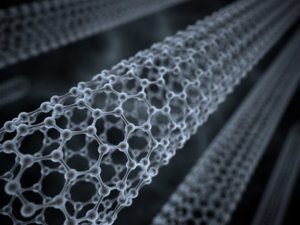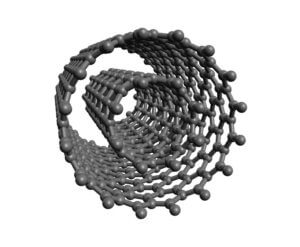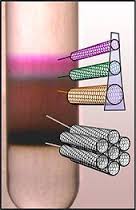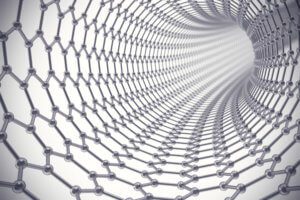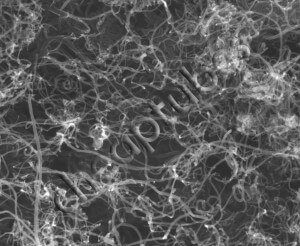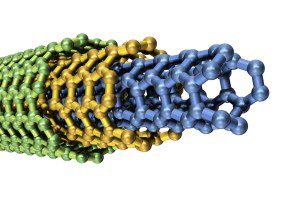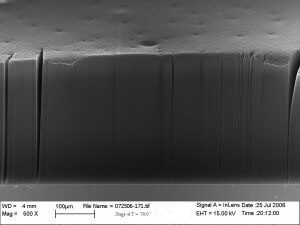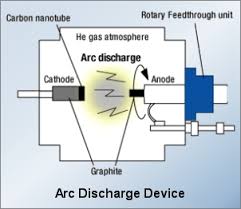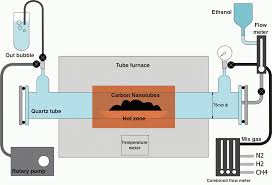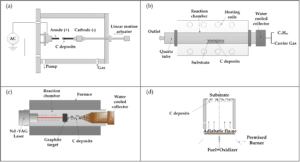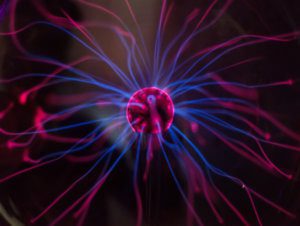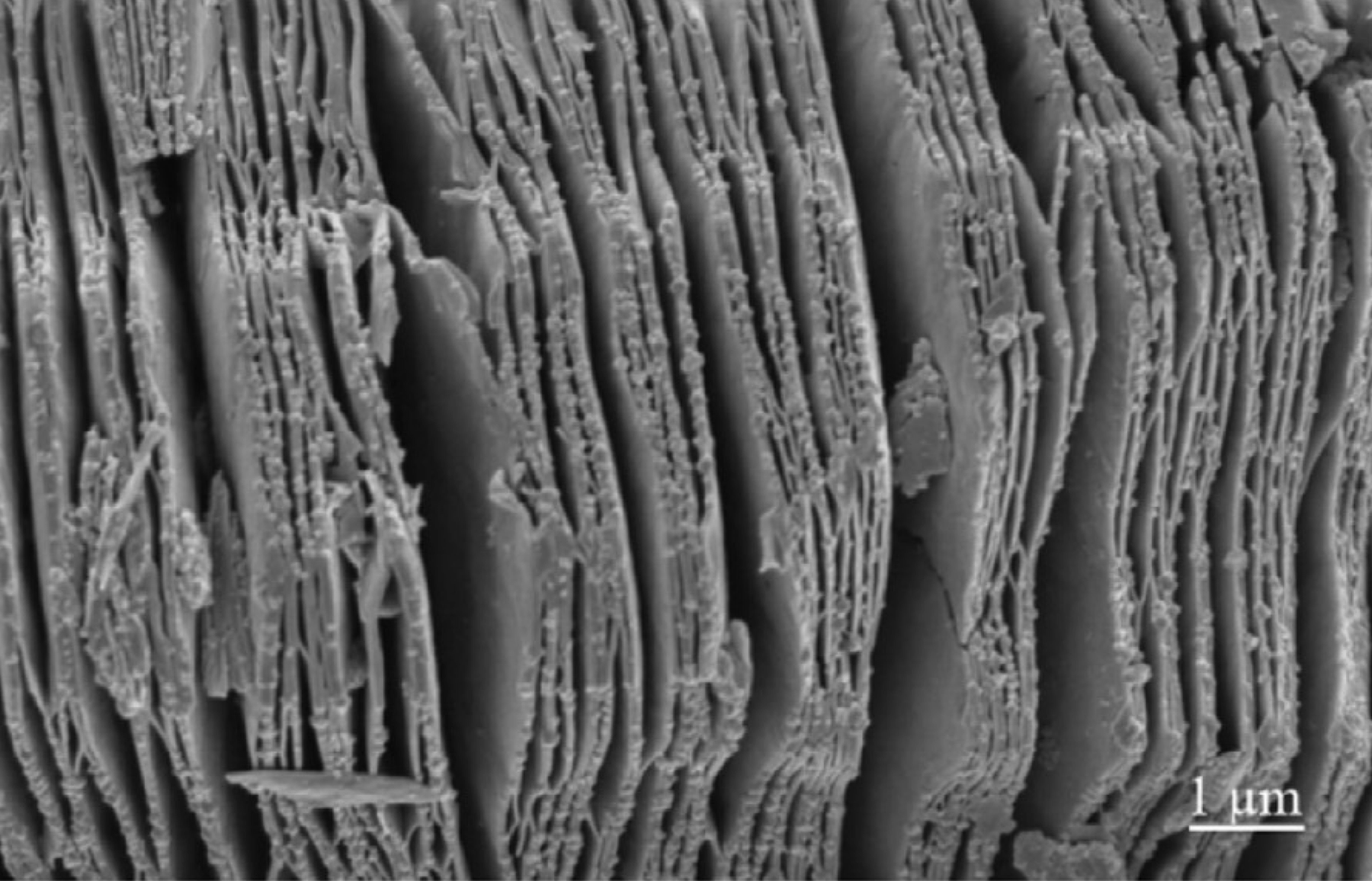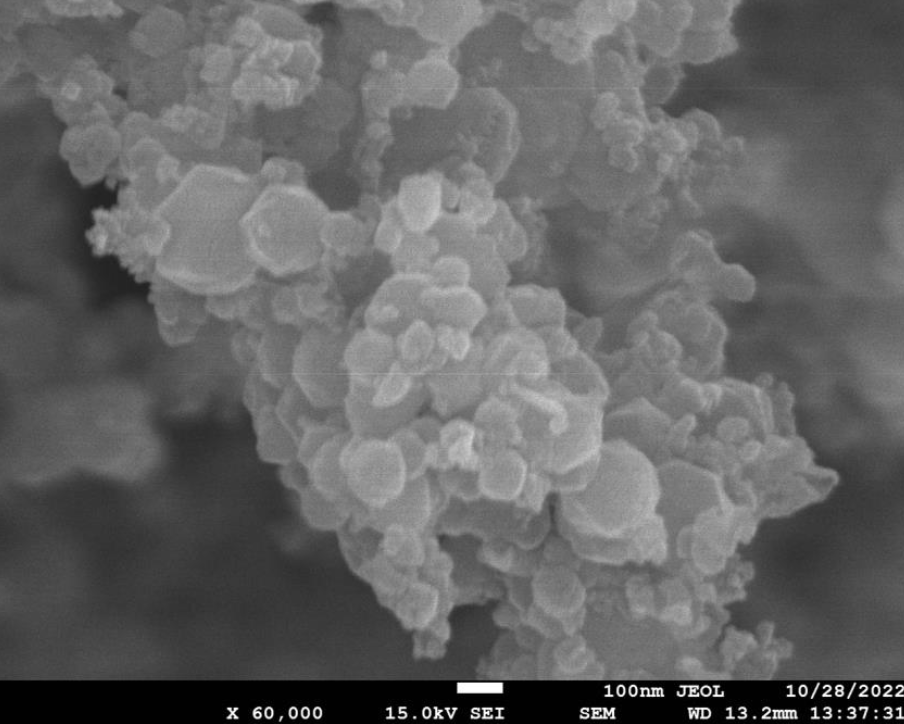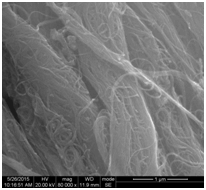Graphene Biosensors
Properties and Principles of Graphene Biosensors
Graphene’s mechanical, electrical and optical properties are the most useful for biosensing applications. It’s high mechanical strength, Young’s modulus, flexibility, and tensile strength are key properties during the fabrication process, as the surface is strong enough to be easily modified/be used to modify other surfaces. Efficient biosensors work by providing a high electron transfer rate between the electrode and the biomolecule. Graphene’s high charge mobility and electron transfer properties help to facilitate the electron movement between the target biomolecule and the sensor, making it a useful material in biosensing applications. The doping ability and electrical conductivity of graphene makes it an ideal choice for mobilizing charge carriers in a sensor. When biomolecules are adsorbed onto a sheet of graphene, a change in the charge carrier density changes the electrical conductivity. The change in conductivity causes an electrical response that is measurable, which can be used to identify whether a molecule has been sensed or not. Graphene is also transparent to visible-light wavelengths, making it useful in optical-based biosensors where the higher density of states of a biomolecule improves the surface electromagnetic wave propagation. Optical properties can be utilized in such situations where DNA bases wish to be identified, but not double stranded DNA.
There are also four principles that are utilized when graphene used to sense biomolecules. These are: using graphene as electron transfer materials, electrochemical impedance materials, as field effect transistors (FETs) and as photon/phonon transfer materials.
Electron Transfer Materials
Graphene is exploited as an electron transfer material because its high surface area can expose all of the carbon atoms to the target biomolecules, increasing the sensitivity (or it gives the potential for an increased sensitivity). The low noise also gives a higher sensitivity. Graphene can also be used as an electric transfer medium in sensors, where its high mobility and electrical conductivity help to facilitate the movement of charge and electron through the sensor. Graphene is also able to act as an electron transport material by physically binding to the biomolecule and shifting electrons through bonding interactions.
Impedance Materials
To be used as an impedance material, graphene can be used to functionalise the electrode surface within a biosensor. Graphene’s delocalised π-network forms π-π stacking interactions which can anchor other π-conjugated molecules onto the electrode. This method provides a method to modify the surface of graphene in biosensors without disturbing its desirable electrical conductivity properties. The high surface area of graphene provides many anchoring/binding sites for both target molecules and fabricated metal nanoparticles (which are sometimes used to improve the sensing efficiencies of biosensors). The aromatic domains on the graphene sheet (and ionic regions if metal nanoparticles are present) allow the graphene sensor to interact in various ways, which can increase the sensitivity against non-graphene biosensors.
FETs
Using graphene as a suspended FET in FET-biosensors produces an enhancement in the sensitivity, owing to the interfacial charge traps which act as external scattering centres and degrade transport properties. Graphene is incorporated into two types of FET-based biosensors- back gate and liquid gate. In back gate FETs, the change in a threshold/source-drain voltage causes the conductivity of graphene to change, allowing for a higher sensitivity to be recorded. In liquid gates FETs, graphene is very susceptible to a change in the surrounding liquid environment, whether it be by ion density or a surface charge, which produces a higher detection sensitivity compared to other non-graphene liquid gate FET biosensors. The surface of the graphene sheet can also be functionalised to be selective to a single biomolecule. The graphene sheet can detect electronic changes in the surrounding liquid medium by two different mechanisms- electrostatic gating mechanisms and surface transfer doping. Electrostatic gating mechanisms exploit the hole density, which leads to a change in the overall conductivity of graphene causing a sensing response. Surface transfer doping is when a dopant/biomolecule induces a shift in the gate voltage of the graphene gate and causes a left shift of the Dirac point by a charge transfer mechanism, which represents a transfer of electrons from the biomolecule to the graphene gate. Such mechanisms invoke a response which can be detected and measured i.e. the electron transfer causes the molecule to be sensed. Direct binding of biomolecules can also invoke a similar response, as the number of electron scattering centres becomes increased, resulting in a decrease in the mobility of graphene’s charge carriers.
Photon/Phonon Transfer
There are two main mechanisms that determine photon and phonon transfer through graphene. These are electrochemiluminescence (ECL) and fluorescence.
ECL (without graphene) has two mechanisms; annihilation and co-reactant. Both mechanisms involve intermediate complexes undergoing an electron transfer reaction on the surface of the electrode. Such mechanisms promote electrons into higher orbital states, where upon light is released when they return to their ground state. Graphene, however, produces two opposing mechanisms; ECL enhancement and ECL quenching. Graphene’s intrinsic electrical conductivity and mobility promote the quantum yield of the luminophore, which is normally limited by the electron transfer of a number of linked luminophores. Graphene’s efficient electrical properties promotes efficient electron transfer which induces a greater concentration of intermediate species to higher electronic states, per unit time. This, coupled with graphene’s high surface area provides a high concentration of sites for both luminophores and target biomolecules, all of which increases the sensitivity of the sensor.
Graphene (particularly GO) can also quench the ECL mechanism due to resonance energy transfer. There is a critical point for ECL intensity. Below this, the incorporation of graphene into the sensor increases the ECL intensity. Above this, the ECL intensity will decrease, even if graphene is continued to be added into the matrix. This mechanism is not fully understood to date, but it is believed to be a product of the blackbody effect.
Graphene also has the ability to fluoresce and quench fluorescence. Graphene can be used in sensors to detect the fluorescence imposed onto the graphene (or GO) sheet by photo-induced charge transfer and fluorescence resonance energy transfer mechanisms. Graphene (and GO) can also be used as an energy quencher for organic fluorophores and nanomaterials. The quenching mechanism for these types undergoes also undergoes a fluorescence resonance energy transfer mechanism.
Glucose
With more than 30 different derivatives documented, graphene sensors that can detect glucose are a widely-established area. Depending on the type of sensor, sensitivities can range from 0.64-1100 µA mM-1 cm -2 and the linear range can vary between 0.05 µm and 32 mm. Many types of graphene electrode can be implemented into glucose sensors. Glucose sensors today contain many graphene derivatives that are composited with both biological and non-biological materials. The two main types of graphene electrodes employed in glucose sensors are enzymatic and non-enzymatic electrodes. The most common glucose sensors are developed using enzymatic components and the sensing range for a glucose sensor generally lies between 1-60 mM. This is also the range for both diabetic and non-diabetic blood glucose levels.
Whilst many variations of graphene can be utilised (including graphene nanosheets, nanoflowers, nanocubes, graphene ionic liquids, poly-functionalised graphene and graphene paper), pure graphene and reduced graphene oxide (rGO) are the most common graphene derivatives used in glucose sensing. They form a wide range of composites with metal nanoparticles, polymers and conducting polymers, which are used to modify electrode surfaces.
The sensing of glucose relies on two main factors- the efficient transfer of electrons between the glucose and the graphene and the presence of a catalytic material. The interaction of glucose and graphene produces well-defined redox peaks, which provides and efficient electron transfer system. The redox potential between glucose and graphene is reversible, with a rate constant is 2.83 s-1, which is a much higher rate when compared to other carbon allotrope sensors, e.g. CNTs. Graphene also exhibits a high loading capacity of glucose onto its surface, due to its high surface area. Graphene glucose sensors almost always utilise metal nanoparticles on their surface due to their ability to enhance the sensitivity, electron transfer and response times.
An inexpensive, non-enzymatic, disposable sensor strip has been developed on the small scale, using a copper-graphene nanocomposite, to measure the glucose concentration in human tear fluids. The electrodes in these sensors contain surface modifications of copper nanoparticles, as the size and distribution of such nanoparticles play a big role in the optimization of the sensor. A larger copper concentration increase the output of the signal, due to an increased number of reactions between the copper ions and the glucose molecules. The incorporation of graphene in the matrix creates a uniform distribution of copper NPs by controlling the electrodeposition under an applied voltage. By using oxygenated graphene (GO, rGO etc), the surface functional groups help to bind the copper nanoparticles in place, which helps to facilitate the exhibited uniform distribution. These glucose strips show a linear relationship between the current applied and the amount of glucose sensed, with an optimal working potential of 0.5 V. These sensors have a sensitivity of 1101 µA mM-1 cm-2 with detection limits between 0.025 and 0.9 mM. These glucose strip sensors are also consistent, with a reproducibility of 91%. They also show a high stability. After 10 sensing cycles (with an applied current), over a 30-day period, the sensors have shown to exhibit a maximum loss of 17.2%.
Enzyme-modified graphene solution-gated transistors can be used as high performance glucose sensors. These glucose sensors are a type of solution-gated graphene transistors (SGGTs). SGGT’s have been found across various applications to provide, real-time, sensitive sensing with a high throughput. They can also operate in low voltages and aqueous environments, both of which are valuable properties for sensing biomolecules. The sensing mechanism of these sensors revolves around interactions between the biomolecules and the sensors channels/gates. The channels and gates in these glucose sensors are made of CVD graphene and the gate electrodes are modified with glucose oxidase (GOx) enzymes, biocompatible polymers and platinum nanoparticles. The sensors work by oxidizing the glucose (GOx catalysed reaction) which generates hydrogen peroxide at the gates. The hydrogen peroxide is then oxidized, which regulates the effective gate voltage applied on the transistor. The sensors are sensitive to the voltage changes, which allows for a detection signal to be recorded. These sensors can show detection limits for glucose and hydrogen peroxide at 0.5 µM and 30 nM, respectively. The high sensitivity of these sensors make them a great candidate for non-invasive glucose sensors, which detect glucose in human bodily fluids such as saliva. Other SGGTs which have been modified with glucose oxidase have also been recorded, with detection limits of 0.1-10.9 mM.
Other notable glucose sensors are those containing Nafion/GOx/multilayer film of ionic liquid–sulfonic acid-functionalized graphene, GOx/TiO2 NP-graphene/GCE and Pt nanoflowers/GO/GCE, which show sensitivities of 0.0718 nA µM-1, 6.2 µA mM-1 cm-2 and 0.64-1.26 µA mM-1 cm-2, respectively. 3-D graphene foam modified with cobalt oxide nanowires also show a very low detection limit of 25 nM.
DNA
Graphene can be used to distinguish individual nucleotide bases, single strand DNA and double strand DNA.
One of the simplest single strand DNA detection mechanisms is via immobilization of the DNA strand onto a functionalized graphene sheet (GO, rGO etc). Single strand DNA exhibits an orientation where all the nucleobases lie flat, which is favourable due to graphene’s planar/flat nature and high surface area. The bonding and hybridization between the amino-terminated groups of the DNA and the oxygen-based functional groups on the graphene sheet form amide bonds. Using a graphene sheet with a higher concentration of carboxylic acid groups (i.e. rGO), improves the surface interaction between graphene and the DNA strand, due to the increased number of potential binding sites. Functionalized graphene can also bioconjugate with terminal sulphur groups on single strand DNA, although this is less common. The absorption of single strand DNA is very efficient, to the point where most of the bases become absorbed on to the graphene sheet and the helical structure can be destroyed.
Sensors based around various principles including fluorescence, electrochemical, electrical and SERS assays can be used for sensitive and selective double strand DNA recognition. Double strand DNA does not bind as strongly to graphene as single strand DNA does, due to a lower number of intermolecular interactions at the reactive interface. Single and double strand DNA can be differentiated by sensors using other non-conventional various methods with graphene as the binding material, including colorimetry, chemiluminescence and mass spectrometry. Many sensing methods for the detection (and differentiation) of DNA using graphene revolve around π-π stacking interactions and other intermolecular forces.
Graphene utilizes its exposed edge planes to catalyse and oxidise DNA bases better than any other electrode material. A sensor modified with graphene can exhibit up to a 4-fold greater sensitivity to DNA bases than other materials (including other carbon allotropes such as CNTs). Some reduced graphene oxide, dependent upon their functionalization, can detect and distinguish all four nucleotide bases and polymorphism in short oligonucleotides. All the four bases exhibit different local density of states (LDOS) and interaction energies. The LDOS leave fingerprints specific to each base, which can be detected by local electron tunnelling conductance. The high conductivity of graphene allows for a higher detection sensitivity of these fingerprints.
There are many different types of DNA sensor currently being researched, which incorporate the various mechanisms and principles discussed. One example is the utilization of graphene oxide and NaYF4:Yb,Er@SiO2 nanoparticles. Like many DNA sensors, the driving mechanism is based around the π-π interactions between the carbon atoms (of the graphene) and the nucleobases (of the DNA). The interaction produces a fluorescence resonance energy transfer (FRET) quenching mechanism due to the overlap of the emission and absorption spectrums. These sensors have shown detection limits as low as 5 pM, with a selectivity for single stranded DNA.
A graphene-FET based sensor has also been developed to detect mismatched DNA and polymorphisms. These graphene sensors have a much simpler and cheaper fabrication compared to other polymorphism sensors. They also have a high specificity and the ability to detect a single nucleotide mismatch. The sensors measure a resistance induced by a displaced nucleotide strand, which induces a current change (of which graphene is highly sensitive to) and a shift in the Dirac point. The main advantage of these sensors is the ability to detect a single mismatch which is label-free and with high resolution. These sensors are a very recent discovery which have the potential to form the basis for a commercial diagnostic point of care tool for early treatment of life-threatening diseases.
Graphene quantum dots (GQDs) have also started to gain attention as DNA sensors. Double strand has a poor affinity to large sheet graphene, hence the preference to single strand selectivity. GQDs show a higher intercalation with DNA due to their smaller size. The higher intercalation can promote DNA cleavage, so there is a future potential for GQDs to be a selective sensor for double strand DNA, once optimized.
There are many different types of sensor for detecting various DNA forms. Other notable sensors include a ssDNA/azophloxine/graphene nanosheets sensor with a detection limit of 0.4 fM, a ssDNA/Au nanorods/GO/GCE sensor with a detection range of 0.035-3.5 fM and a ssDNA/GO–chitosan/ITO sensor with a detection limit of 10 fM.
Proteins
Another growing area with graphene based sensors is in the detection of proteins. Protein sensors are used to detect complex proteins such antibodies and biomarkers for use as diagnostic testing tools. Many protein sensors without graphene suffer from a lack of flexibility, making graphene a great material for composite protein sensors.
A graphene nanoFET protein biosensor has been developed using CVD-grown graphene to detect thrombin biomarkers. Unlike other graphene-based FETs for protein sensing (which generally use exfoliated graphene), the use of CVD-grown graphene allows for an easier scalability, easier fabrication procedure, larger sensing area and are reusable. They also provide similar advantages to other similar sensors such as low noise and high transconductance. The sensor is used to detect real-time binding (and unbinding) of thrombin protein biomarkers using the change in electrical current produced by the binding-unbinding mechanisms. These sensors are also able to measure the binding kinetics during the binding-unbinding processes. These sensors have an effective gate voltage of 0.21 mV min-1, with a dissociation constant of 170 nM. The sensor can be regenerated with a simple rinse of buffer solution, which removes any bound protein on the surface. The surface of the sensor also contains a DNA aptamer which is specific for binding to thrombin. These DNA aptamers have a half-life of 10 hours i.e. 50% of the aptamer will have removed itself after 10 hours, but the device themselves have a shelf-life of over a week.
A protein sensor using thermally reduced graphene oxide (TRGO) and gold nanoparticles conjugated with antibodies. The sensor response, like many biosensors, occurs when a protein binds to the nanoparticle/antibody conjugates which induces a change in conductivity in the TRGO sheet. The signal is recorded by FET and direct current measurements. They are fabricated via many techniques including e-beam lithography, dispersion and suspension methods and multiple annealing steps. The AuNPs tested so far have been 10 and 20 nm in diameter, with 12 and 48 antibodies per each NP, respectively. These sensors have a much higher sensitivity than many other carbon-based protein sensors, with a detection limit of 0.2 ng ml-1. This sensor has been developed off an unoptimized predecessor with an order of magnitude improved sensitivity, so the potential for these sensors may not have yet been reached, and the sensitivity could be further increased (although this has been stated by the researchers themselves that it would be a hard task).
A primitive bioelectronic sensor to detect proteins that fluoresce using a graphene FET with biological and inorganic functional groups has also been developed. The sensor works by detecting tagged proteins (e.g polyhistidine) which bind via the tag itself. The device provides an electric readout for each given protein by measuring the proteins optimal excitation wavelength. By knowing the excitation wavelength and making the surface multi-functional, they have the potential to be used as diagnostic tools in the future for the detection of various protein species. The single protein detection devices to date adopt a p-type structure with a hole mobility’s between 300-2000 cm2 V s-1.
Other Small biomolecules
Aside from the main three biosensors described, other small biomolecules such as cells, electroactive analytes, dopamine and uric acid (to name a few) can now be detected by various graphene-based sensors.
Graphene can be used as a biocompatible substrate to enhance the adhesion and growth of cells to detect cell populations. Graphene oxide with a negatively charged surface can be used to interact with positively charged poly-L-lysine, which results in a biocompatible interface that promotes cell adhesion for the detection of 30 cell mL-1. A composite film of chemically rGO and carboxymethyl chitosan with folic acid molecules anchored to the surface can be used for the detection of tumour cells which have a folate receptor, at a rate of 500 cells mL-1. Another nanocomposite consisting of chemically rGO and 3,4,9,10-perylenetetracarboxylic acid can be used to detect breast and cervical carcinoma cells at a rate of 1000 cell mL-1. These nanocomposites are deposited onto an electrode where the carboxylic acid groups are linked to a specific aptamer that binds to nucelolin (and overexpressed protein in the carcinoma cells).
A common component of many small molecule sensors is either GCE or a graphite/GCE composite. However, many of these are being phased out and chemically reduced graphene oxide is being used to replace the graphite component, mainly due to its higher electron transfer rate. The oxidation/reduction potentials to detect H2O2 (a common enzymatic byproduct) for GCE/Chemically rGO are 0.2/0.1 V compared to 0.8/-0.35 V and 0.7/-0.25 V for graphite/GCE and GCE, respectively. Chemically rGO also exhibits a wide linear range with values between 0.05-1500 µM than other sensors due to a higher concentration of edge plane defect. Chemically rGO electrodes also show great electron transfer rates for NADH at 0.4 V, which is 0.3 V lower than GCE/graphite sensor electrodes. Chemically rGO electrodes show a great deal of promise in terms of linearity and limits of detection (LOD).
For ascorbic acid, they show an LOD of 0.07 µM with a linearity of 0.1-106 µM. The electrodes can be heavily modified by a series of moieties, nanoparticles and inks to produce LOD’s that are wider ranging from 5 nM to 1.2 µM with linearity’s between 0.15-4500 µM. Chemically rGO/GCE electrodes shows a LOD of 0.12 µM and a linearity 0f 0.5-2000 µM for dopamine. Functionalized chemically rGO/GCE electrodes show LOD’s as low as 22 nM with linearity’s ranging from 0.2-4000 µM. For uric acid, chemically rGO/GCE has a LOD of 0.2 µM with a linearity of 0.8-2500 µM. Modified electrodes can show an LOD of 0.088 µM with linearity’s of 0.1-1000 µM. In previous non-graphene sensors, the selectivity between dopamine, uric acid and ascorbic acid has always been poor as the sensors could not distinguish between these three molecules. These are also three of the most studied small biomolecules. The sp2 planes and edge defects exhibited by graphene produces a greater number of π-π interactions that can be used to distinguish dopamine from other small biomolecules. There is still further work required to distinguish between other biomolecules, but using graphene instead of other carbon allotropes shows a step in the right direction for producing selective and sensitive small molecule biosensors.
Design of Experiments
Glucose Sensor
There are many glucose sensors that can be fabricated, but here we focus on the SGGT sensor described above, as there is a great potential for this sensor to become more commercially available than other glucose sensors.
To start, a series of solutions need to be prepared before fabrication. A CHIT polymer solution needs to made up (the rest can be used as purchased). To make the solution, dissolve CHIT (0.5g) in an acetic solution (100 mL, 50 mM, pH 5-6) and electromagnetically stir overnight store in a refrigerator (4 °C). Prepare a GOx stock solution by dissolving in PBS and storing in a refrigerator (4 °C). Dilute a 5 %wt Nafion solution 10 times with isopropanol before use.
To fabricate the device, deposit Au/Cr source and drain electrodes onto glass substrates by magneton sputtering, using a shadow mask. The Cr is used as an adhesion layer for the Au. Grow single layer graphene by CVD on Cu foil (alternatively, this can be purchased) and transfer to the glass substrate with the Au electrodes. Pattern the graphene films by standard lithography to produce the graphene channel and gate. [In this case, the gate electrode was defined as 3 x 3 mm and the channel width and lengths were 0.2 and 3 mm, respectively]. Attach a PDMS wall to the substrate to enable the testing of the device in PBS solution.
Modify the graphene gate electrodes with Pt NPs by electrochemical deposition (5 mM H2PtCl6/0.1 M HCl aqueous solution). Apply a constant voltage (+0.2V, 120 s) to optimize the deposition. Rinse the graphene/Pt NPs with de-ionized water and use as the gate electrode.
To prepare the GOx-CHIT/Nafion/PtNPs/graphene electrode, mix the GOx stock solution (50 µL) with the CHIT solution (0.5 %wt) and sonicate for 15 minutes. Take the graphene gate electrode and drop Nafion (10 µL, 0.5 %wt) onto the surface of the gate and dry at room temperature. After that, drop coat the GOx-CHIT mixture (10 µL) onto the gate electrode and refrigerate overnight (4 °C) to dry the GOx-CHIT film. Wash the device with de-ionized water to remove unwanted residues and store in the refrigerator for future use.
DNA Sensor
Here we look at the novel sensor that has the potential for commercial use. As described above, it is a sensor that can detect mismatching of DNA to a single nucleobase mismatch, so it could have great importance once optimized.
To fabricate the sensor, place the graphene onto copper foil and spin coat PMMA onto the topside of the graphene sheet. Etch away the bottom of the graphene. PMMA acts as the supporting layer for the graphene sheet after etching the copper. Remove the back-side of the graphene by oxygen plasma etching and cut into pieces with scissors (tests done to date use 4 x 6 mm pieces). Etch the copper by floatation with ammonium persulfate (0.1 M, 5 hours) and rinse with deionized water overnight. Transfer the PMMA supported graphene sheet onto a SiO2-coated silicon wafer, then remove the PMMA layer with acetone (60 °C, 1 hour). Anneal the sample under a hydrogen/argon atmosphere (300 °C, 2 hours). To fabricate the transistor, use silver paste as the conducting and drain electrodes at two ends of the graphene sheet. Use silicone rubber as the insulate for the source and drain electrodes.
Protein Sensor
Here is the detailed production step of a the nanoFET protein sensor, as described above. The sensor shows a great promise for scalability and larger scale production, so it is a great example of a sensor that should be reproduced and optimized.
To make the sensor, first, either grow or purchase CVD-grown grapehene (on Cu foil) and spin coat PMMA (2% solution of 495 Mw PMMA in anisole) onto a square piece of graphene (1.5 x 1.5 cm). Place the coated graphene square into a copper etchant (4 hours) and then clean the device by soaking it in deionized water baths for at least 12 hours and transfer onto the device substrate (Si/SiO2 with 500 nm oxide and pre-defined alignment marks). Dry the device (30 °C, 4 hours) and remove the excess PMMA by open-air heating (350°C, 4 hours). Pattern graphene ribbons (3 µm x 10 µm) using photolithography and an O2 plasma etcher.
After patterning, fabricate metal electrodes (1.5 nm Cr/30 nm Au) using standard lithography, metallization and lift-off methods. This leaves an exposed graphene area of 3 x 3 µm and is the active sensing area (24 in total over the device). Remove the residues by annealing the device (400 °C, Ar/H2 atmosphere). To make the surface preferential for protein binding, treat the device with pyrenebutanoic acid succinimidyl ester (PBASE) and a thrombin-specific DNA-based aptamer.
Future Advancements
Many graphene-based biosensors have only been tested on the small/laboratory scale. The next big step, like many graphene composite materials, is to optimize their sensitivity and selectivity to push production to commercial levels. For sensors that are looking to analyse in-vivo, discovering the toxicological and biocompatibility effects of graphene will decide if the sensors are to be used in this capacity. Many graphene biosensors exhibit similar sensitivities to other non-graphene biosensors, but can exhibit beneficial properties such as enhanced flexibility, conductivity and selectivity to certain molecules. To take these sensors to the next level in terms of production, an increase in the sensitivity to greater levels (to confidently surpass existing sensors) is needed, as is the ability to be able to select and distinguish between various biomolecules. The ability to do the latter will push graphene-based biosensors to significant heights above their non-graphene counterparts. This should be the focus and it is the property that will offer the most benefit for commercial applications e.g. as multi-functional diagnostic tools.
References:
Kumar S., Luong J.H.T., Recent advances in electrochemical biosensing schemes using graphene and graphene-based nanocomposites, Carbon, 2014, 84(1), 519-550
Tehrani F., Reiner L., Bavarian B., Rapid prototyping of a high sensitivity graphene based glucose sensor strip, PLoS ONE, 2015, 10(12), 1-11
Wang F., Liu L., Li W., Graphene-based glucose sensors: A brief review, IEEE Transactions on Nanobioscience, 2015, 14(8), 818-834
Zhang M., Liao C., Mak C.H., You P., Mak C.L., Yan F., Highly sensitive glucose sensors based on enzyme-modified whole-graphene solution-gated transistors, Scientific Reports, 2015, 5:8311, 1-6
Hu Y., Li F., Han D., Niu L., Biocompatible graphene for bioanalytical applications, Springer, 2015, VIII, Chapter 2, pages 11-33.
Alonso-Cristobal P., Vilela P., El-Sagheer A., Lopez-Cabarcos E., Brown T., Muskens O. L., Rubio-Retama J., Kanaras A. G., Highly sensitive DNA sensor based on upconversion nanoparticles and graphene oxide, ACS Appl. Mater. Interfaces, 2015, 7, 12422−12429
Hwang M. T., Landon B. P., Lee J., Choi D., Mo A. H., Glinsky G., Lal R., Highly specific SNP detection using 2D graphene electronics and DNA strand displacement, PNAS, 2016, 113(26), 7088-7093
Saltzgaber G., Wojcik P., Sharf T., Leyden M. R., Wardini J. L., Heist C. A., Adenuga A. A., Remcho V. T., Minot E. D., Scalable graphene field-effect sensors for specific protein detection, Nanotechnology, 2013, 24, 355502
Mao S., Yu K., Lu G., Chen J., Highly sensitive protein sensor based on thermally-reduced graphene oxide field-effect transistor, Nano Res., 2011, 4(10), 921-930
Lu Y., Lerner M. B., Qi Z. J., Mitala Jr. J. J., Lim J. H., Discher B. M., Johnson A. T. C., Graphene-protein bioelectronic devices with wavelength-dependent photoresponse, Applied Physics Letters, 2012, 100, 033110



